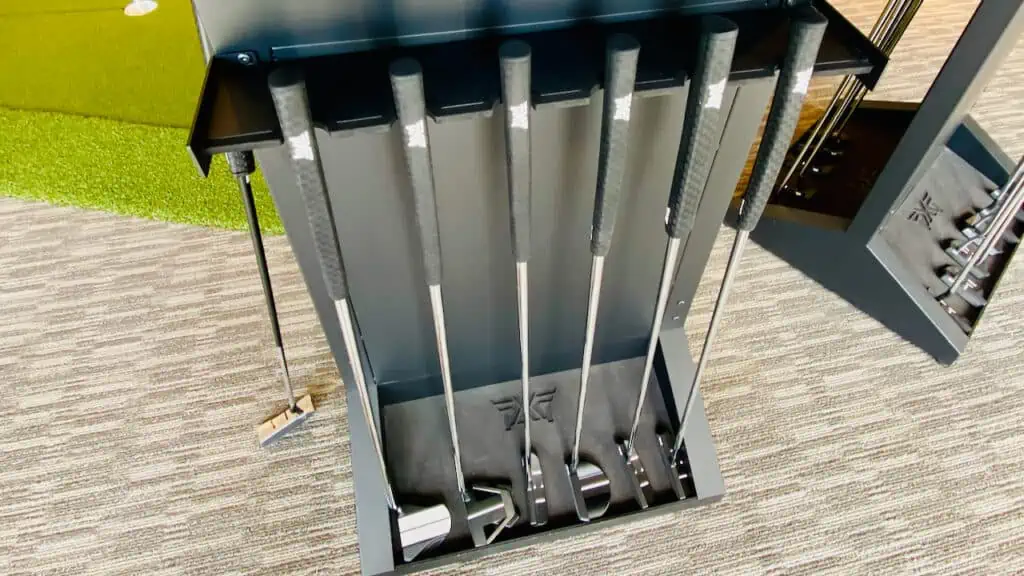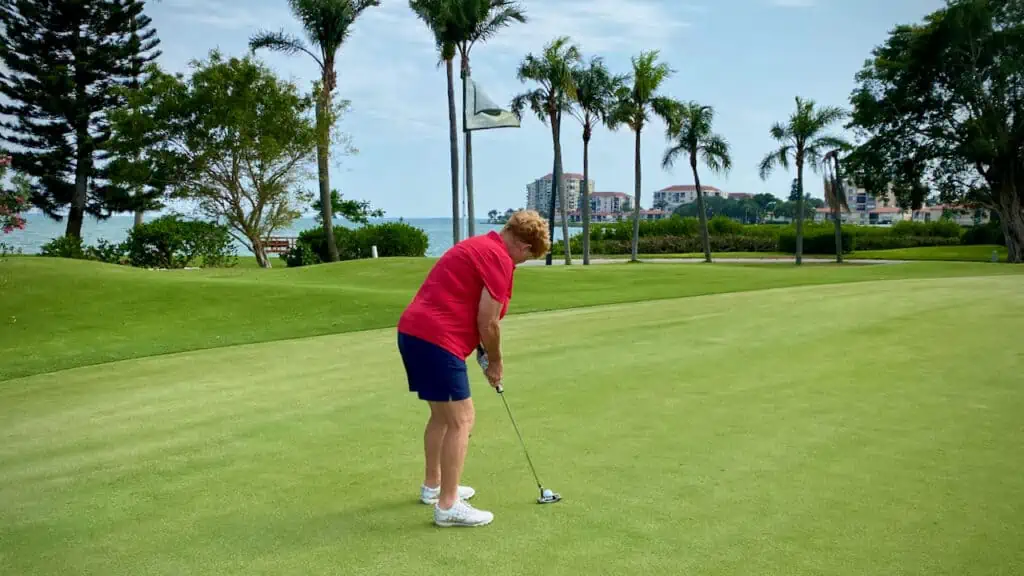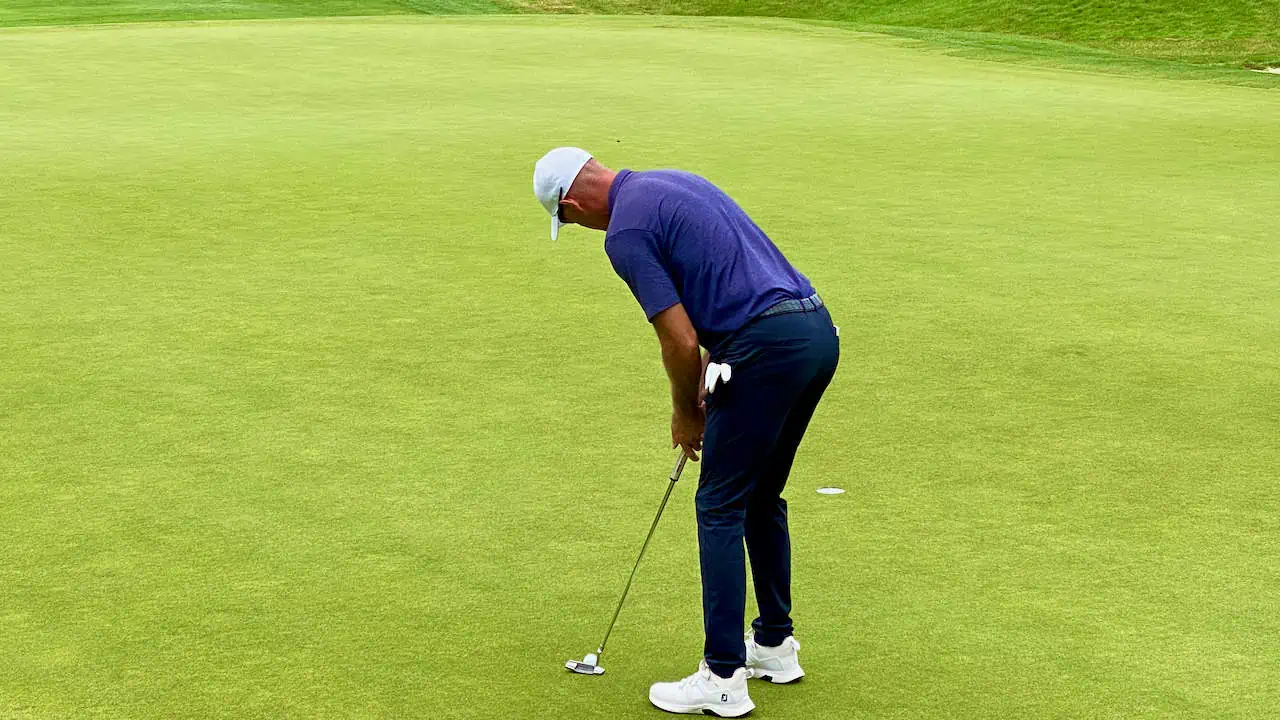Table of Contents
Looking for simple putting tips for seniors? Our golf expert demonstrates putting drills at home that don’t require anything but you and your putter.
The “Flat Stick,” “Texas Wedge,” or the “Short Stick” are all nicknames for the putter. Some of us use a more robust vocabulary when it comes to the “Money Maker.” Depending on your outlook on the putter, it can either be viewed as a blessing or a curse to your game.
This putting tips for seniors article will serve as your “all-in-one” comprehensive roadmap to better understand players’ most common mistakes on the putting surface.
Unfortunately, self-proclaimed gurus have provided contradicting information that can ruin your time on the course and defeat your attitude. As a Class A Professional Golfer, I’ve seen it all on the golf course!
Are you a 10 – 15 handicap with multiple 3-putts per round? Do you struggle with reading breaks? Do you feel defeated when you step on the green?
Let’s take a deep breath and hit the pause button on what we currently know about the putting stroke. We will start with tour-proven, pre-swing concepts followed by best putting practices. As I guide you, I will insert my putting lessons to enhance your understanding further.
Read Next: 10 Key Golf Mental Game Strategies to Birdie More Holes

Are You Putting Skills Better or Worse than Your Golf Handicap?
Here’s a quick breakdown of average putting statistics by amateur golfers based on handicap.
| Number of Putts by Golf Handicap | Average Number of Putts |
|---|---|
| 0 handicap | 3 putts every 39.2 holes |
| 10 handicap | 3 putts every 14.9 holes |
| 15 handicap | 3 putts every 10.4 holes |
| 20 handicap | 3 putts every 8.2 holes |
| 25 handicap | 3 putts every 7.6 holes |
As you may gather from the chart above, 0-10 handicap players tend to limit their 3-putts from 1 to 2 times every couple of rounds played, while 15+ handicap golfers experience 3-putts more frequently.
Long story short: Lower the number of putts, and you’ll lower your overall golf handicap!
While this may be easier said than done, the following putting tips for seniors will help you get there.
Putting Mistakes to Avoid

The biggest putting mistakes are usually two factors: putter design and your putting setup. The combination of putter design and setup will directly affect the path on which your putter head travels.
Before I show the proper position, I want to ensure you are playing the correct putter style. Simply playing golf with any putter isn’t a good idea for better accuracy and distance control. If your putter doesn’t match your putting stroke, it can significantly deter you from success on the green.
Putter Style & Design Factors to Consider
- Blade Putter – a traditional thin-looking putter that is typically not a face-balanced putter.
- Mallet Putter – a larger putter head that weighs more than a blade style putter and reduces putter face rotation.
- Putter Length – the further away you stand from the putter head, the greater the arc. This also plays a significant role in posture.
- Lie Angle – if the angle is more upright, then the putting stroke will require less arc in the movement of the putter head.
- Putter Grip – when it comes to a putter grip, play what feels comfortable. Too often, players develop robotic, stiff movements that decrease the feel in their arms and hands.
If you’re not sure what type of putter is best for you, you should consider getting a putter fitting.
Tips + Putting Drills at Home for Seniors
In this section, I’ll demonstrate some of my favorite putting drills at home that don’t require extra golf training equipment. These are ideally suited for older golfers, but anyone can truly practice them.
Importance of Your Lower Body Posture
The first element of putting setup that will increase your chances of routinely striking the ball center on the putter face is stance. The goal is to eliminate lower body movement so your torso can control tempo and range of movement.
If you tend to hit the ball inconsistently, then learning how to stabilize your lower body is paramount to your success. If your balance is less than optimal, your stance and ability to maintain a solid foundation are in question. As a result, if there is lower body movement during your stroke, then you may incur some difficulties with distance control.
Distance control is directly related to your ability to use slope to funnel the ball to the cup.
For example, if the speed is too fast, then the ball will not break with the slope correctly. Also, if the speed is too slow, then the golf ball will react to the slope and break more than necessary. It’s safe to assume that 3-putts stem from a first bad putt. We can all agree that being on the green in regulation and walking away with a bogey is more than frustrating.
Best Putting Tips for Stabilizing Your Lower Body:
- Purchase rubber balance pads to stand on while practicing your stroke.
- Exercises such as squats or wall sits to strengthen your legs.
- Bend your knees
- Kettlebell thrust and squats (see medical disclaimer)
Staying Centered in Your Putting Stance

The second senior putting tip that deters consistent ball striking is a fixed position of your head. If your head is moving up, down, right, or left, then the club face and path may be altered.
As our joints and bones get older, we lose mobility, resulting in compensations. To illustrate my point, shoulders that lack rotation might need head movement to engage the putting stroke.
Unfortunately, many people have been instructed to start the swing with their shoulders. If you’re a victim of frozen shoulders, this could be the reason for your inconsistencies on the green.
Essentially, the objective of your posture is to set a stance to limit lower body movement. This is done by keeping your head centered and using your torso to initiate movement.
When this is achieved, the distance from the center of your chest and the position of your hands will remain the same throughout the putting stroke. As a result, your path and the quality of your putting stroke will be more consistent.
Fundamentals of the Putting Stroke

Now, we are going to transition into the inswing fundamentals of the putting stroke. To start, here are a few quick tips to consider.
My Favorite Putting Tips for Seniors:
- Routinely test lower body balance with rubber balance disks (they can be found on Amazon and are inexpensive).
- Standing one leg at a time and close your eyes. See how long you can balance on one leg.
- Use a putting mirror to work on your centered head position. Here is a link for Top Senior Practice Aids.
- Relax your arms because stiff arms and shoulders tend to create no feel.
Top Inswing Putting Mistakes: Swing Path & Tempo

Swing Path
One of the most common misconceptions is the swing path. Over the years, I have attended several player development classes and observed one prevalent error. Teachers who instruct their students to swing the putter on a straight back and through stroke often omit to adjust the lie angle or shaft bend of the putter.
Just like the full swing, there is an acceptable path to swing the putter head-on. The average angle of a putter shaft is 70 degrees, so asking someone to swing straight back and forth would be asking them to swing off plane. Unless the putter lie angle is close to 90 degrees, a straight back and trough stroke is going to require manipulation throughout the stroke.
To narrate my point, let’s use an old-style ship anchor to evaluate the path. Placing the anchor on the ground so the part that’s attached to the chain is skyward.
Next, follow the bottom of the anchor to visualize the path so one endpoints directly at the target. If the top is perfectly vertical to the horizon, then the path to target is a straight line.
However, if the top angle starts to tilt towards the player (as it usually would), you will notice that the path appears to curve more around the body. This is where the shaft bend will affect your intended path.
The concept of playing a putter that is perfectly vertical to the horizon sounds good in theory. It’s not as easy as it sounds because the angle of attack starts to become more downward, which can cause issues with spin and how the golf ball rolls.
Let me demonstrate what I mean in this short video.
Putting Swing Path & Tempo Video Demonstration
Tempo
I have seen many different approaches to putting, but the one constant ingredient necessary is tempo.
Tempo relates to the speed of the start, middle, and finish of the putting stroke. If the speed is too slow, then the putter face and path start to become unstable. Likewise, if the tempo becomes too fast, then the distance control and sequence will decrease.
One standard method of teaching is to accelerate through impact. I’m not saying this method doesn’t work, but let’s take Jordan Speith, Ricky Fowler, and Patrick Cantlay, for example.
All three have been recognized for their ability to putt. The main factor that remained consistent for all three players was the tempo and how they released the putter through impact.
If you were to freeze their swings post-impact, you would notice that the putter grip stays relatively centered on their body. Opposed to pushing the hands forward so the grip endpoints outside the body, causing the forward stroke to accelerate.
What We Can Learn from Anchor Putting
On January 1, 2016, the USGA and the R&A banned anchor putting due to 4 out of 6 major winners using this technique.
Anchoring was deemed as an illegitimate way of gaining control of the putting stroke. While anchoring the club during play is against the rules, practicing with this technique can offer valuable insights.
Think about the connection between the golf club and your body when you use this style of putting. It highlights how the tempo influences the sequence of your stroke significantly.
For senior golfers experiencing a loss of strength over the years, try mimicking the anchored putting motion during practice. This approach allows you to understand and replicate the smooth, steady tempo and the controlled swing that anchoring provides.
By emulating this motion, you’ll find the club swings with less forced speed and more natural efficiency, enhancing the effectiveness of your stroke without actually breaking the anchoring rule on the course.
⛳️ Related: Best Golf Putters for Senior Golfers to Cut Strokes
Final Thoughts on Putting Tips for Seniors
Without factoring in the mental game, these putting tips for seniors can definitely help you with your putting stroke.
These simple yet impactful drills offer a path to more reliable putting without overhauling your entire approach. Embrace these tweaks and enjoy a game that continues to improve, bringing even more pleasure to your time on the golf course.
Frequently Asked Questions
What is the best way to improve my putting?
The best way to improve your putting is to have a golf professional evaluate your putting setup, path, and tempo.
How can I make my putting stroke more stable?
One of the best ways to make your putting stroke more stable is adding weight to the clubhead and ensuring your tempo is not too slow. This can be done with putter weights or adding some lead tape to the putter head.
How often should I practice putting?
It’s recommended to practice your putting at least three times a week. Focus on lag putts (25’+) and short putts (inside 8’). Use different slopes to help understand speed. If you are unable to go to a golf course, you should consider getting a home putting mat or green.
Can seniors anchor their putter?
On January 1, 2016, the USGA and the R&A banned anchor putting due to 4 out of 6 major winners using this technique. Anchoring was deemed as an illegitimate way of gaining control of the putting stroke, and this rule applies also to senior golfers.
What senior tour golfers used anchor putting?
Ernie Els used anchor putting when it was legal on the tour but then switched to a cross-handed putting grip.

